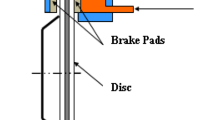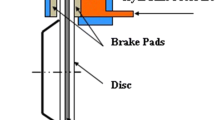Abstract
This research presents a computational approach to estimate the heat transfer of solid and vented brake discs. Based on research data, it has been observed that when driving at slower speeds, a vented rotor’s effectiveness in cooling greatly decreases, with most of the cooling being generated by the additional surface area. The measurement of heat transfer in commercial vehicle disc brakes is determined using standard connections and road test results. The objective is to achieve an excellent degree of system dependability at a low cost. The automotive sector is placing growing importance on technology-driven safety features, highlighting their increasing significance. Braking is a method of converting motion energy into thermal power, which needs to be dissipated as heat. Overheating may result in brake system breakdown, which is dangerous. Temperature stability is achieved through the thermal dissipation through the brake disc. The current study employed a novel approach to calculate the brake disc's coefficient of heat transmission and heat flow through the disc. The occurrence of autonomous vehicles provides a lot of potential advantages, both on a personal and community basis, including improved security and energy efficiency, greater heat loss, and less traffic concerns, among other things. According to Jiguang and Fei (Open Mech Eng J 9:371–378, 2015) and More and Sivakumar (Int J Eng Res Appl 4(4):01–05, 2014), temperature rises about 10 percent of the calculated value. Inside a brake disc and padding, temperature measurement to variations was ± 6% as that estimated by Newcomb (Proc Inst Mech Eng Automob Div 12:227–244, 1958. 10.1243/PIME_AUTO_1958_000_028_02). At the high temperature of 450–650 °K, road speed would have to be approximately 80, 90, and 100 km/h for the vehicle under study. Higher-powered cars that use giant discs would need a road speed of 150 km/h in a single brake application. This information was then used to optimize the disc's boundaries and groove configuration to achieve maximum heat dissipation. Consequently, a significant increase in heat dissipation was observed by simply modifying the vane design with straight and drilling grooves. The percentage of total energy that has been dissipated in the brake linings is 1/17.92, which means that about 5.57 percent of the heat produced is absorbed by the linings. A rotor using straight vanes and 36 grooves performed highest in this study, and the approach used to calculate the transmission of heat across various disc sections has helped us comprehend commercial vehicle brake dissipation of heat.




















Similar content being viewed by others
Data availability
The data will be made available on kind request to corresponding author.
Abbreviations
- CFD:
-
Computational fluid dynamics
- ICEM:
-
Integrated computer engineering and manufacturing
- HTC:
-
Heat transfer coefficient
- RNG:
-
Renormalization group
- FEM:
-
Finite element method
- FEA:
-
Finite element analysis
- C p :
-
Specific heat capacity
- V :
-
Linear speed at any instant
- A :
-
Surface area of a disc brake rotor
- ε :
-
Turbulent dissipation rate or the turbulent kinetic energy dissipation rate
- ф :
-
Angular displacement
- h :
-
Heat transfer coefficient
- D :
-
Measurement of the size of the disc
- K a :
-
Surface roughness thermal conductivity
- m :
-
Mass
- P :
-
Pressure
- Re:
-
Reynolds number of the rotor
- α :
-
Thermal diffusivity
- P FV :
-
Braking force
- t :
-
Duration of the disc
- v 0 :
-
Disc's beginning velocity
- a :
-
Acceleration
- Q :
-
Cooling power
- z :
-
Rate of braking
- g :
-
Standard momentum of gravitation
References
Adamowicz A, Grzes P (2011) Analysis of disc brake temperature distribution during single braking under non-axisymmetric load. Appl Therm Eng 31:1003–1012
Agrawal VK, Khairnar HP (2022) Experimental & analytical investigation for optimization of disc brake heat dissipation using CFD. Evergreen 9(4):1076–1089. https://doi.org/10.5109/6625720
Agrawal VK, Khairnar HP (2023) Analytical modeling of heat transfer coefficient analysis in dimensionless number of an electric parking brake using CFD. Int J Eng IJE Transections B Appl 36(2):276–288
Balasubramanyam N, Prashanti G (2014) Design and analysis of disc brake rotor for two wheeler. Int J Mech Ind Technol 1(1):7–12
Barecki Z, Scieszka SF (1989) Some factors influencing friction brake performance: part 2—a mathematical model of the brake shoe and the brake path system
Belhocine A, Bouchetara M (2012a) Thermomechanical modelling of dry contacts in automotive disc brake. Int J Therm Sci 60:161–170. https://doi.org/10.1016/j.ijthermalsci.2012.05.006
Belhocine A, Bouchetara M (2012b) Thermal analysis of a solid brake disc. Appl Therm Eng 32:59–67. https://doi.org/10.1016/j.applthermaleng.2011.08.029
Belhocine A, Bakar AA, Bouchetara M (2014) Numerical modeling of disc brake system in frictional contact. Tribol Ind 36:49
Belhocine A, Wan-Omar WZ (2017) CFD modeling and computation of convective heat coefficient transfer of automotive disc brake rotors. Revista científica, pp 116–128
Bryant D, Fieldhouse JD, Talbot CJ (2011) Brake judder-an investigation of the thermo-elastic and thermo-plastic effects during braking. Int J Veh Struct Syst 3(1):58–73
Degenstein T, Winner H (2006) Dynamic measurement of the forces in the friction area of a disc brake during a braking process. Institute of Automotive Engineering Department at technischeUniversitat Darmstadt
Eriksson M, Jacobson S (2000) Tribological surfaces of organic brake pads. Tribol Int 33:817–827
Eriksson M, Bergman F, Jacobson S (2002) On the nature of tribological contact in automotive brakes. Wear 252:26–36. https://doi.org/10.1016/S0043-1648(01)00849-3
Floquet A, Dubourg M-C (1996) Realistic braking operation simulation of ventilated disk brakes
Floquet A, Baïetto-dubourg M (1994) Nonaxisymmetric effects for three-dimensional analysis of a brake. J Tribol 116:401
FrontechChina, n.d. What are the four major parts of a disc brake system. URL https://www.frontechchina.com/what-are-the-four-major-parts-of-a-disc-brake-system/. Accessed 26 Oct 02021
Gao CH, Lin XZ (2002) Transient temperature field analysis of a brake in a non-axisymmetric three-dimensional model. J Mater Process Technol 129:513–517
Ghadimi B, Kowsary F, Khorami M (2013a) Thermal analysis of locomotive wheel-mounted brake disc. Appl Therm Eng 51:948–952
Ghadimi B, Sajedi R, Kowsary F (2013b) 3D investigation of thermal stresses in a locomotive ventilated brake disc based on a conjugate thermo-fluid coupling boundary conditions. Int Commun Heat Mass Transfer 49:104–109
Giri NK, Munir A, Kong J (2020) An integrated safe and secure approach for authentication and secret key establishment in automotive cyber-physical systems. In: Arai K, Kapoor S, Bhatia R (eds) Intelligent computing, advances in intelligent systems and computing. Springer International Publishing, Cham, pp 545–559. https://doi.org/10.1007/978-3-030-52243-8_39
Ilinca A, Ilinca F, Falah B (2001) Numerical and analytical investigation of temperature distribution in a brake drum with simulated defects. IJVD 26:146. https://doi.org/10.1504/IJVD.2001.001935
Jaligama SK, Choudhary P, Kumar KC, Prashanth B, Sreekanth D (2020) CFD and thermal analysis of ATV disc brake. Int J Res Technol 07:1511–1516
Jiang L, Jiang Y, Liang YU, Nan SU, Ding Y (2012) Thermal analysis for brake disks of SiC/6061 Al alloy co-continuous composite for CRH3 during emergency braking considering airflow cooling. Trans Nonferrous Met Soc China 22:2783–2791
Jiguang C, Fei G (2015) Temperature field and thermal stress analyses of high-speed train brake disc under pad variations. Open Mech Eng J 9:371–378
Khairnar HP, Phalle VM, Mantha SS (2015) Estimation of automotive brake drum-shoe interface friction coefficient under varying conditions of longitudinal forces using Simulink. Friction 3:214–227
Kim D-J, Lee Y-M, Park J-S, Seok C-S (2008) Thermal stress analysis for a disk brake of railway vehicles with consideration of the pressure distribution on a frictional surface. Mater Sci Eng A 483:456–459
Kothawade S, Patankar A, Kulkarni R, Ingale S (2016) Determination of heat transfer coefficient of brake rotor using CFD simulation. Int J Mech Eng Technol (IJMET) 7(3):276–284
Limpert R (975) Cooling analysis of disc brake rotors. SAE Technical Paper
More AV, Sivakumar R (2014) CFD analysis of automotive ventilated disc brake rotor. Int J Eng Res Appl 4(4):01–05
Natarajan N, Vijayarangan S, Rajendran I (2007) Fabrication, testing and thermal analysis of metal matrix composite brake drum. IJVD 44:339. https://doi.org/10.1504/IJVD.2007.013648
Newcomb TP (1958) Transient temperatures in brake drums and linings. Proc Inst Mech Eng Automob Div 12:227–244. https://doi.org/10.1243/PIME_AUTO_1958_000_028_02
Newcomb TP, Millner N (1965) Cooling rates of brake drums and discs. Proc Inst Mech Eng Automob Div 180:191–205. https://doi.org/10.1243/PIME_AUTO_1965_180_019_02
Newcomb TP (1979) Thermal aspects of railway braking. In: Institution of Mechanical Engineers Conference Pub
Ostermeyer GP, Müller M (2008) New insights into the tribology of brake systems. Proc Inst Mech Eng Part D J Automob Eng 222:1167–1200. https://doi.org/10.1243/09544070JAUTO595
Park SB, Lee KS, Lee DH (2007) An investigation of local heat transfer characteristics in a ventilated disc brake with helically fluted surfaces. J Mech Sci Technol 21:2178–2187. https://doi.org/10.1007/BF03177478
Patel P, Mohite MA (2017) Design optimization of passenger car front brake disc for improvement in thermal behavior, weight & cost reduction. Int J Eng Dev Res 5(2):1079–1086
Patil L, Khairnar H (2022) Python inspired smart braking system to improve active safety for electric vehicles. IJAME 19:9447–9459. https://doi.org/10.15282/ijame.19.1.2022.08.0727
Patil LN, Khairnar HP, Hole JA, Mate DM, Dube AV, Panchal RN, Hiwase VB (2022) An experimental investigation of wear particles emission and noise level from smart braking system. Evergreen 9:711–720. https://doi.org/10.5109/4843103
Petersson P, Salazar G (2013) Post impact stability control verifcation in driving simulator
Shelar KA, Barve SB, Chopade MR, Chaudhari PE (2014) Thermal analysis of automotive brake rotor. Int J Curr Eng Technol (3):129–132
Talati F, Jalalifar S (2009) Analysis of heat conduction in a disk brake system. Heat Mass Transf 45:1047–1059
Voller GP, Tirovic M, Morris R, Gibbens P (2003) Analysis of automotive disc brake cooling characteristics. J Automob Eng 217(8):657–666
Vyas J, Zinzuvadia M, Kathadi MI (2014) Design analysis & optimization of an automotive disc brake. Int J Adv Eng Res Sci 1(3):24–29
Vyas J, Zinzuvadia M, Kathadi MI (2017) Design and analysis of solid and cross-drilled disc brake rotors. In: International conference on research and innovations in science, engineering & technology 1: 294–301
Wurm J, Fitl M, Gumpesberger M, Väisänen E, Hochenauer C (2016) Novel CFD approach for the thermal analysis of a continuous variable transmission (CVT). Appl Therm Eng 103:159–169. https://doi.org/10.1016/j.applthermaleng.2016.04.092
Yevtushenko AA, Adamowicz A, Grzes P (2013) Three-dimensional FE model for the calculation of temperature of a disc brake at temperature-dependent coefficients of friction. Int Commun Heat Mass Transfer 42:18–24
Author information
Authors and Affiliations
Contributions
All Authors have equal Contribution.
Corresponding author
Ethics declarations
Conflict of interest
The authors declare no competing interests.
Additional information
Publisher's Note
Springer Nature remains neutral with regard to jurisdictional claims in published maps and institutional affiliations.
Rights and permissions
Springer Nature or its licensor (e.g. a society or other partner) holds exclusive rights to this article under a publishing agreement with the author(s) or other rightsholder(s); author self-archiving of the accepted manuscript version of this article is solely governed by the terms of such publishing agreement and applicable law.
About this article
Cite this article
Agrawal, V.K., Patil, L.N., Chavan, K.V. et al. A computational analysis of heat transfer in solid and vented disc brakes: CFD simulation and thermal performance assessment. Multiscale and Multidiscip. Model. Exp. and Des. (2024). https://doi.org/10.1007/s41939-024-00400-y
Received:
Accepted:
Published:
DOI: https://doi.org/10.1007/s41939-024-00400-y




